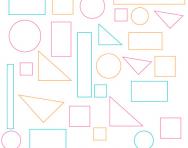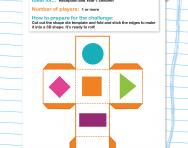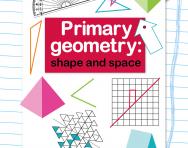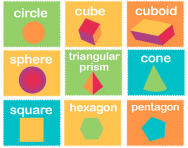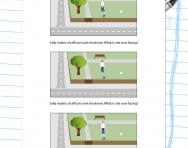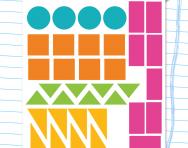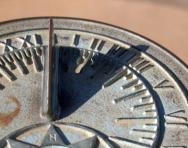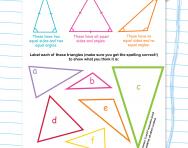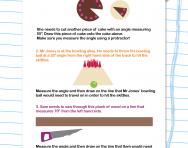Teachers' tricks for shape, space and geometry
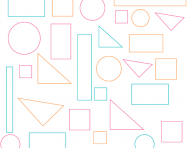
Learn to recognise 2D and 3D shapes
In Reception and Key Stage 1, children will learn to name 2D and 3D shapes and will begin to understand their properties (numbers of sides, faces, edges, vertices, etc.).
By the end of KS1, children need to know the names of common 2D shapes such as: rectangle, square, circle, triangle, pentagon, hexagon and octagon.
They also need to know the names of common 3D shapes, such as: cube, cuboid, pyramid, sphere, cylinder, triangular prism and cone.
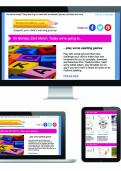
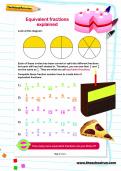
Boost Your Child's English & Maths!
- Weekly programme for each school year
- Worksheets sent direct to your inbox
- Keeps your child's learning on track
There are plenty of games you can play at home to help your child with shapes:
- Play shape I-spy: Play the classic game but using shapes instead of letters, for example, “I spy something that has a green circle in the middle” etc.
- Draw shapes in your mind: For example, “Imagine an enormous hexagon on the floor, how many sides does it have?”
- Hide-a-shape: Prepare a tray with different shapes on it. Ask them to look at the tray then close their eyes. Remove one shape; which one have you hidden?
- Go for a shape walk: See if they can spot five 2D and five 3D shapes by walking around the house or garden. Spotting shapes in everyday objects will help them to see how shapes feature in the world.
- Supermarket shape-shop: In the supermarket, see if your child can find the following 3D shapes: a cylinder, a cuboid, a cube, a sphere and a triangular prism. (Hopefully, these objects will correspond to items you need to buy!) Take them home and lay them out on a table. Ask your child to point at a shape that has more than 6 edges, a shape that has a circular face, a shape that has only three faces, etc. If any of the shapes happen to contain chocolate this could be a good incentive for them to complete the task...
Get crafty with shapes
Tessellating shapes fit together, like tiles, without gaps. Children can have fun using various shapes to make different tessellating patterns. Doing such patterning can help them to learn about the features of shapes.
Some of the objectives that fall under Shape and space relate to position and direction. Get younger children used to the vocabulary by playing hide and seek with objects, or asking them to put things under / beside / on top of other things.
To encourage them to use shape- and direction-related language (flat, curved, square, round, next to, beside, etc.) try this activity: give them an old birthday card with a picture on the front. They can cut the card out into many pieces.
Encourage them to make different shapes and sizes; once they have done this they can then try to stick it together as a jigsaw. Encourage them to look carefully at how edges and corners slot together, looking for straight and curvy lines.
Use directional language
As children move through primary school they’ll be taught to use directional language. This starts with children making and talking about 'turns,' which then forms the basis for learning about angles later on. Other 'position and direction' concepts that are learnt include co-ordinates and translating and reflecting shapes.
- In Reception, children use everyday words to describe position, such as: above, next to, under, inside. To help them practise, play a version of hide and seek where they tell you where to hide (under a chair, behind a desk, between two chairs) while someone else does the seeking.
- In Year 1 they need to recognise whole, half, quarter and three-quarter turns and continue to use words to describe position.
- In Year 2, they need to give instructions involving position, direction and movement. They also need to use the words anti-clockwise and clockwise when discussing whole, half and quarter turns and know that a right angle is a quarter turn. Try a modified Simon Says game to put these concepts into action, asking them to make a quarter turn clockwise, then make a half turn anti-clockwise, and so on.
- In Year 3, children need to know that one right angle is a quarter turn, two are a half turn, three a three-quarter turn and four a full turn.
- In Year 4, they need to identify acute and obtuse angles, and compare and order angles. They need to describe positions on a 2D grid as co-ordinates in the first quadrant. They need to translate objects left to right and up to down.
- In Year 5, children need to draw and measure angles using a protractor and calculate angles on a straight line, at a point and within a right angle. They need to reflect and translate shapes on a grid.
- In Year 6, children need to work out where a shape will be after rotation through 90˚ or 180˚. They continue to measure and draw angles using a protractor and calculate angles in a triangle or around a point. Again, ask them to turn themselves to understand how shapes turn: get them to stand in the middle of a room and turn 90˚ clockwise. Can they then turn 180˚ anti-clockwise? Ask them what they will be facing if they turn 360˚ clockwise. They will also be asked to find unknown angles in triangles, quadrilaterals and regular polygons. They need to describe positions on the full co-ordinate grid (all four quadrants). They need to draw shapes on the co-ordinate plane and then reflect and translate them.
Make some prisms
Building prisms in card or paper is a fantastic way for children to see how 3D shapes are made up. Use pre-prepared nets (opened-up shapes) to get started; you can download the nets of a cube, cuboid, cylinder and prism from TheSchoolRun.
As children get older encourage them to work out and design their own nets to put together into 3D shapes. This way they’re really having to think about the different faces, angles and symmetry of shapes.
To give this activity more meaning, they can decorate the boxes as flat nets and add a personal (and educational) touch to gift boxes or other craft activities.

Give your child a headstart
- FREE articles & expert information
- FREE resources & activities
- FREE homework help
